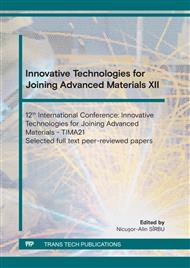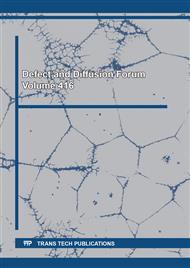[1]
Bevilacqua M., Ciarapica F.E., Forcellese A., Simoncini M.- Comparison among the environmental impact of solid state and fusion welding processes in joining an aluminium alloy. Proceedings of the Institution of Mechanical Engineers, Part B: Journal of Engineering Manufacture. 2020 Jan;234(1-2):140-56.
DOI: 10.1177/0954405419845572
Google Scholar
[2]
Meng X., Huang Y., Cao J., Shen J., dos Santos J.F. -Recent progress on control strategies for inherent issues in friction stir welding. Progress in Materials Science. 2021 Jan 1;115:100706.
DOI: 10.1016/j.pmatsci.2020.100706
Google Scholar
[3]
Verma S, Kumar V, Kumar R, Sidhu RS. Exploring the application domain of friction stir welding in aluminum and other alloys. Materials Today: Proceedings. 2021 Aug 3.
DOI: 10.1016/j.matpr.2021.07.449
Google Scholar
[4]
Cojocaru R., Boțilă L.N., Dașcău H.F., Duma I. - Improving the quality of Cu99 welded joints using friction stir welding process in shielding gas environment, Welding and Material Testing - BID year XXIX, no. 4/(2020).
Google Scholar
[5]
Cojocaru, R., Boțilă, L. N., Ciucă, C., & Verbiţchi, V. - ISIM Contributions to the Development of Friction Welding Procedures. In Key Engineering Materials (Vol. 890, pp.82-94). Trans Tech Publications Ltd. (2021).
DOI: 10.4028/www.scientific.net/kem.890.82
Google Scholar
[6]
Boțilă, L. N., Cojocaru, R., Ciucă, C., & Verbiţchi, V. Processes Developed Based on Friction Stir Welding Process. In Key Engineering Materials (Vol. 890, p.66–75). Trans Tech Publications, Ltd. (2021).
DOI: 10.4028/www.scientific.net/kem.890.66
Google Scholar
[7]
Iwaszko, J., Kudła, K. - Microstructure, hardness, and wear resistance of AZ91 magnesium alloy produced by friction stir processing with air-cooling. Int J Adv Manuf Technol 116,1309–1323 (2021).
DOI: 10.1007/s00170-021-07474-9
Google Scholar
[8]
Cojocaru R., Botila L.N., Ciuca C. - Infrared thermo graphic technique–viable alternative for monitoring of friction processing processes - Welding & Material Testing - BID year XXIX, no. 1/(2020).
Google Scholar
[9]
Afrin N., Chen D.L., Cao X., Jahazi M. - Microstructure and tensile properties of friction stir welded AZ31B magnesium alloy, Materials Science and Engineering: A, Volume 472, Issues 1–2, 2008, Pages 179-186, ISSN 0921-5093.
DOI: 10.1016/j.msea.2007.03.018
Google Scholar
[10]
Greß T., Stahl J., Mittler T., Spano L., Chen H., Khalifa N. B., Volk W. -Mechanical characterization of as-cast AA7075/6060 and CuSn6/Cu99.5 compounds using an experimental and numerical push-out test, Materials Science and Engineering: A, Volume 751,2019,Pages 214-225,ISSN 0921-5093.
DOI: 10.1016/j.msea.2019.02.080
Google Scholar
[11]
Murariu, A. C. Non-destructive and mechanical tests for quality evaluation of friction stir welding joints,. Welding & Material Testing - BID year XXIX, no. 1 (2020).
Google Scholar
[12]
Suneesh E., Sivapragash M.- Multi-response optimisation of micro-milling performance while machining a novel magnesium alloy and its alumina composites, Measurement, Volume 168, 2021, 108345, ISSN 0263-2241.
DOI: 10.1016/j.measurement.2020.108345
Google Scholar
[13]
Khan, N., Iqbal, A., Siddiquee, A. -Friction Stir Welding of different Joint Configurations: A Review. Journal of Material Science and Mechanical Engineering. 2, (2015), pp.19-24.
Google Scholar
[14]
Lima Fortunato J. M. - Friction Stir Weld bonding. Defect Inspection and Mechanical Characterization, Instituto Superior Técnico, Lisbon, Portugal, November (2016).
Google Scholar
[15]
Xin R., Liu D., Li B., Sun L., Zhou Z., Liu Q. -Mechanisms of fracture and inhomogeneous deformation on transverse tensile test of friction-stir-processed AZ31 Mg alloy. Materials Science and Engineering: A, Volume 565, 2013, Pages 333-341, ISSN 0921-5093.
DOI: 10.1016/j.msea.2012.12.053
Google Scholar



